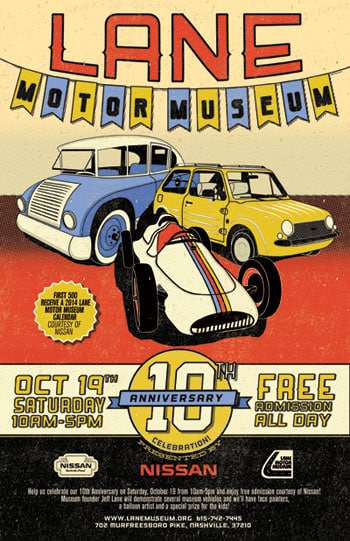Lane Motor Museum’s 10th Anniversary Celebration!
Presented by Nissan
Saturday, October 19th- 10am-5pm
- Free Admission all day!
- First 500 receive a free 2014 Lane Motor Museum Calendar- Courtesy of Nissan!
- Museum founder Jeff Lane will demonstrate several museum vehicles, museum mechanic Michael Hüby will discuss the museum’s Gyro-X project and David Bishop of Nissan will present their “Job 1” truck– the first Nissan produced in Symyrna TN and North America! a
- We’ll have face painters and a balloon artist for the kids. Every child receives a special prize!
- (Scroll down for a detailed schedule of events!)
——————————————————————————————————————————
Lane Motor Museum will celebrate 10 years in Nashville by opening its doors to the public for a free day on Saturday, October 19th, 2013 from 10am-5pm. In addition, the first 500 guests through the door will receive a free 2014 Lane Motor Museum calendar– all courtesy of presenting sponsor, Nissan.
The day will begin at 9:45 am with a welcome from museum founder, Jeff Lane, Nashville Mayor Karl Dean and Vinay Shahani, Director of Marketing Communications for Nissan North America. The museum will open its doors for the public by 10:00 am when 2014 museum calendars will be distributed to the first 500 guests. Throughout the day the museum will offer demonstrations of their vehicles including talks about the process for their Gyro-X restoration project. David Bishop, Senior Manager of Product Development Aftersales Division for Nissan & curator of the Nissan Heritage Collection, will present Nissan’s “Job 1” truck — a 1983 Nissan pickup truck that is not only the first Nissan produced at their plant in Smyrna, TN but the first produced in North America. Kids can enjoy the museum’s kids play area as well as face painters, balloon artists,and a special museum giveaway for kids!
Schedule of Events
9:45 AM
Welcoming remarks featuring museum founder, Jeff Lane, Nashville Mayor Karl Dean,
and Vinay Shahani, Director of Marketing Communications for Nissan North America
10:00 AM
Lane Motor Museum opens to the public for a free day and the first 500 will also receive a free 2014 museum calendar–all courtesy of Nissan!
10:30 AM
Lane Motor Museum mechanic Michael Hüby talks about the museum’s Gyro-X Restoration project.
11:00 AM
David Bishop, Senior Manager of Product Development Aftersales Division for Nissan & curator of the Nissan Heritage Collection, will present “Job 1” truck– — a 1983 Nissan pickup truck that is not only the first Nissan produced at their plant in Smyrna, TN but the first produced in North America
12:00 PM
Museum Founder, Jeff Lane, will demonstrate the museum’s 1896 Ford Quadricycle Replica, the 1965 Peel P-50 and the 1932 Helicron.
1:00 PM
David Bishop, Senior Manager of Product Development Aftersales Division for Nissan & curator of the Nissan Heritage Collection, will present “Job 1” truck– — a 1983 Nissan pickup truck that is not only the first Nissan produced at their plant in Smyrna, TN but the first produced in North America.
2:00 PM
Museum Founder, Jeff Lane, will talk about the history of Tatra and demonstrate the museum’s Mochet Velocar.
3:00 PM
Museum Founder, Jeff Lane, will demonstrate the museum’s 1896 Ford Quadricycle Replica, the 1965 Peel P-50 and the 1932 Helicron.
4:00 PM
Lane Motor Museum mechanic Michael Hüby talks about the museum’s Gyro-X Restoration project.
About Lane Motor Museum
At Lane Motor Museum, visitors can enjoy the largest collection of European cars in the United States. Approximately 150 cars and motorcycles are on display that represents countries from Asia, Europe, and North and South America, and date from 1922 to 2008. Highlights of the Museum include the largest Czechoslovakian vehicle collection outside Europe, microcars, amphibious vehicles, alternative fuel vehicles, competition cars, motorcycles, military vehicles, and prototypes. The Museum also offers a display of automotive art, a special play area for children, and a gift shop.
Lane Motor Museum is open Thursday-Monday from 10 a.m. to 5 p.m. and is closed on Tuesdays and Wednesdays as well as Thanksgiving Day, Christmas Day & New Year’s Day. Though free for the anniversary event on October 19th, admission is regularly $9 for adults, $6 for seniors (65+), $3 for youth (ages 6-17) and free for age 5 and under.
Lane Motor Museum is located at 702 Murfreesboro Pike just minutes from downtown Nashville. For more information, call (615) 742-7445 or visit the website at www.LaneMuseum.org.

